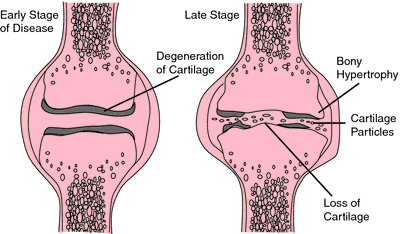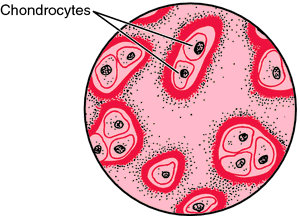Medical term:
gristle
cartilage
[kahr´tĭ-lij]a specialized, fibrous connective tissue present in adults, and forming most of the temporary skeleton in the embryo, providing a model in which most of the bones develop, and constituting an important part of the organism's growth mechanism; the three most important types are hyaline cartilage, elastic cartilage, and fibrocartilage. Also, a general term for a mass of such tissue in a particular site in the body.

Involvement of joint and cartilage in osteoarthritis. From ARHP Arthritis Teaching Slide Collection, American College of Rheumatology.
alar c's the cartilages of the wings of the nose.
aortic cartilage the second costal cartilage on the right side.
arthrodial cartilage (articular cartilage) that lining the articular surfaces of synovial joints.
arytenoid c's two pyramid-shaped cartilages of the larynx.
connecting cartilage that connecting the surfaces of an immovable joint.
costal cartilage a bar of hyaline cartilage that attaches a rib to the sternum in the case of true ribs, or to the immediately above rib in the case of the upper false ribs.
cricoid cartilage a ringlike cartilage forming the lower and back part of the larynx.
diarthrodial cartilage articular cartilage.
elastic cartilage cartilage that is more opaque, flexible, and elastic than hyaline cartilage, and is further distinguished by its yellow color. The ground substance is penetrated in all directions by frequently branching fibers that give all of the reactions for elastin.
ensiform cartilage xiphoid process.
fibrous cartilage fibrocartilage.
floating cartilage a detached portion of semilunar cartilage in the knee joint.
hyaline cartilage flexible, somewhat elastic, semitransparent cartilage with an opalescent bluish tint, composed of a basophilic fibril-containing substance with cavities in which the chondrocytes occur.

Hyaline cartilage. The matrix nearest the chondrocytes is intensely staining; although the matrix appears homogeneous, collagen fibrils may be visualized by polarized light or electron microscopy. From Dorland's, 2000.
Meckel's cartilage the ventral cartilage of the first branchial arch.
permanent cartilage cartilage that does not normally become ossified.
Reichert's cartilage the dorsal cartilage of the second branchial arch.
reticular cartilage elastic cartilage.
semilunar cartilage one of the two interarticular cartilages of the knee joint.
temporary cartilage cartilage that is normally destined to be replaced by bone.
thyroid cartilage the shield-shaped cartilage of the larynx, underlying the laryngeal prominence on the surface of the neck.
vomeronasal cartilage either of the two narrow strips of cartilage, one on each side, of the nasal septum supporting the vomeronasal organ.
yellow cartilage elastic cartilage.
Miller-Keane Encyclopedia and Dictionary of Medicine, Nursing, and Allied Health, Seventh Edition. © 2003 by Saunders, an imprint of Elsevier, Inc. All rights reserved.
car·ti·lage
(kar'ti-lij), [TA] Avoid the misspellings cartiledge, cartlage, and other variants.A connective tissue characterized by its nonvascularity and firm consistency; consists of cells (chondrocytes), an interstitial matrix of fibers (collagen), and ground substance (proteoglycans). There are three kinds of cartilage: hyaline cartilage, elastic cartilage, and fibrocartilage. Nonvascular, resilient, flexible connective tissue found primarily in joints, the walls of the thorax, and tubular structures (for example, larynx, air passages, and ears); makes up most of the skeleton in early fetal life, but is slowly replaced by bone. For a gross anatomic description, see cartilago and its subentries.
Synonym(s): cartilago [TA], chondrus (1) , gristle
[L. cartilago (cartilagin-), gristle]
Farlex Partner Medical Dictionary © Farlex 2012
cartilage
(kär′tl-ĭj)n.
A tough, elastic, fibrous connective tissue that is a major constituent of the embryonic and young vertebrate skeleton and in most species is converted largely to bone with maturation. It is found in various parts of the human body, such as the joints, outer ear, and larynx.
The American Heritage® Medical Dictionary Copyright © 2007, 2004 by Houghton Mifflin Company. Published by Houghton Mifflin Company. All rights reserved.
car·ti·lage
(kahr'ti-lăj) [TA]A connective tissue characterized by its nonvascularity and firm consistency; consists of cells (chondrocytes), an interstitial matrix of fibers (collagen), and a ground substance (proteoglycans); found primarily in joints, the walls of the thorax, and tubular structures such as the larynx, air passages, and ears; comprises most of the skeleton in early fetal life, but is slowly replaced by bone. There are three kinds of cartilage: hyaline cartilage, elastic cartilage, and fibrocartilage.
Synonym(s): cartilago [TA] , gristle.
Synonym(s): cartilago [TA] , gristle.
[L. cartilago (cartilagin-), gristle]
Medical Dictionary for the Health Professions and Nursing © Farlex 2012
cartilage
Gristle. A dense form of connective tissue performing various functions in the body such as providing bearing surfaces in the joints, flexible linkages for the ribs, and a supportive tissue in which bone may be formed during growth.Collins Dictionary of Medicine © Robert M. Youngson 2004, 2005
cartilage
orgristle
a form of connective or skeletal tissue with a translucent, smooth, ‘plastic’ consistency, that allows diffusion of solutes through it. Cartilage is characterized by the presence of rounded cartilage corpuscles (CELLS), surrounded by a matrix of mucopolysaccharide (CHONDRIN) in which, besides the cartilage cells, there are numerous collagen fibres. Cartilage forms the first parts of the skull, vertebrae and long bones of the developing embryo but in adult mammals (and many other vertebrates) is largely replaced by bone. It remains at the ends of bones, in joints, at the ventral ends of the ribs and in a few other places to aid low-friction articulation. The types of cartilage are as follows:- hyaline cartilage, which is bluish-white and transluscent and contains some very fine collagen fibres. It is present at rib ends, in tracheal rings, in the nose, in the embryos of all vertebrates and the adult stages of cartilagenous fishes.
- elastic cartilage, containing yellow fibres and present in the ear, the end of the nose, and the EUSTACHIAN TUBE.
- fibrocartilage, containing few cells and large numbers of fibres, and associated with joints subject to severe strains. It is present as discs between the vertebrae and in the pubic symphysis.
Collins Dictionary of Biology, 3rd ed. © W. G. Hale, V. A. Saunders, J. P. Margham 2005
Cartilage
A tough, elastic connective tissue found in the joints, outer ear, nose, larynx, and other parts of the body.
Mentioned in: Achondroplasia, Ehlers-Danlos Syndrome, Osteoarthritis, Rhinoplasty, Septoplasty, Tracheotomy
Gale Encyclopedia of Medicine. Copyright 2008 The Gale Group, Inc. All rights reserved.
car·ti·lage
(kahr'ti-lăj) [TA]Connective tissue characterized by its nonvascularity and firm consistency; consists chondrocytes of collagen, and proteoglycans.
[L. cartilago (cartilagin-), gristle]
Medical Dictionary for the Dental Professions © Farlex 2012
Latest Searches:
actinomycomata - acthib - acrospire - acrosin - acroscleroderma - acromiothoracic - acromioplasty - acrobystiolith - acrisorcin - AcQtrack - acorea - acoflex - acochoerus - acidogenic - acidity - acidimetries - acidimeter - achillotenotomy - achillodynia - acetylization -
- Service manuals - MBI Corp